PRINCETON, NJ -- Gallup's Economic Confidence Index stands at -27 for the week ending Feb. 21, on par with the previous week's -28. The trend, based on roughly 3,500 interviews each week, clearly shows that consumer attitudes have been steady thus far in February, as well as for the past six weeks. The most recent decline in confidence was recorded in mid-January, and followed a modest post-Christmas bounce that ���۴�ýfirst detected in late December.
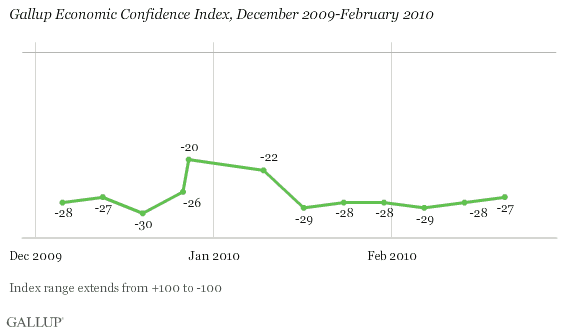
The ���۴�ýEconomic Confidence Index is Americans' answers to two questions -- one asking about in the country and the other about . Both components of the index have been highly stable in recent weeks. However, in late December and early January there was an uptick in consumer optimism about the economy's direction, resulting in the slight improvement to the overall index at those points.
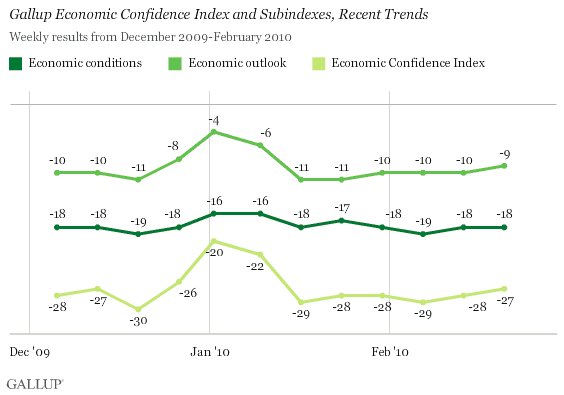
Gallup's weekly findings are based on aggregated results of ���۴�ýDaily tracking interviews with a nationally representative sample of approximately 3,500 U.S. adults per week, and thus provide highly reliable estimates of consumer views.
Conference Board Release Behind the Curve
"As the ���۴�ýtrend suggests, the souring of consumer attitudes that The Conference Board detected with its early February reading most likely set in around mid-January."
Gallup's Economic Confidence Index weekly trend highlights a significant timing issue inherent in The Conference Board's recent release, which stated, "Consumer Confidence, which had been improving over the past few months, declined sharply in February." That report -- showing a drop in consumer confidence from 56.5 in January to 46.0 in February -- is widely credited with rattling the nation's equity markets on Tuesday, helping to drive the Dow Jones Industrial Average down more than 100 points by the close of markets.
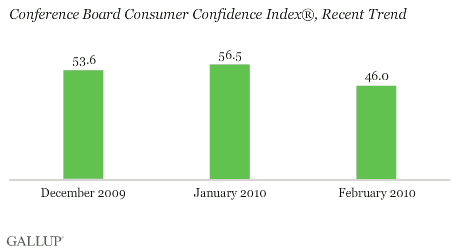
The Conference Board data are based on mail surveys received in the first half of each month, meaning most of those surveys are likely filled out by respondents in the first 10 days of the month. As a result, The Conference Board's Consumer Confidence Index is largely a gauge of consumer attitudes at the beginning of each month. Thus, The Conference Board's finding of a drop in consumer confidence in February in reality describes a decline that happened between early January and early February. Conference Board preliminary numbers are not reported until late in a given month.
As the ���۴�ýtrend suggests, the souring of consumer attitudes that The Conference Board detected with its early February reading most likely set in around mid-January. The February finding looks particularly dramatic in comparison with the slightly elevated level of consumer confidence that The Conference Board found in early January. ���۴�ýdata, however, show that current confidence levels are generally no more negative than they have been for much of the last six months. (This insight has been in near-"real time," both on a weekly basis and in Gallup's daily reporting of continuous three-day rolling averages.

The fact that Gallup's data show little change in economic confidence in recent weeks is not to say that consumer attitudes at present are positive or that they haven't shown some decline since the beginning of the year. Gallup's Economic Confidence Index has been in negative territory since March 2007, and has fallen well below 0, the neutral Index point, for the past two years. However, the -27 figure for Feb. 15-21 is not much different from the values ���۴�ýrecorded in the last quarter of 2009.
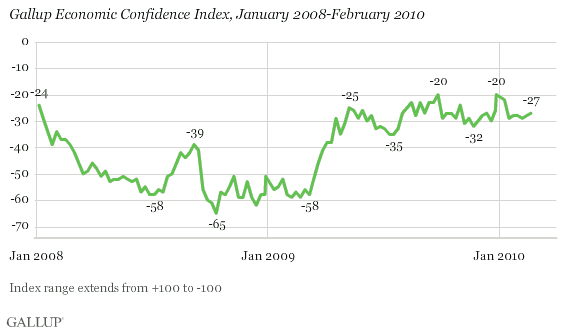
When one focuses just on Gallup's Economic Confidence Index for the first full week of each month (the week most comparable to The Conference Board's field schedule), the results tend to track The Conference Board's monthly Consumer Confidence Index closely. Gallup's ability to monitor attitudes on a continuous basis throughout the month, however, provides a much more complete understanding of how American consumers are feeling about the national economy and its direction -- an understanding not available from surveys conducted in only certain parts of each month.
While The Conference Board's 46.0 reading this month is technically the lowest seen since April 2009 (when it was 40.8), given the likely sample size and associated margins of error around a mail panel survey of its kind, the current reading is essentially the same as the October (48.7) and July 2009 (47.4) readings.
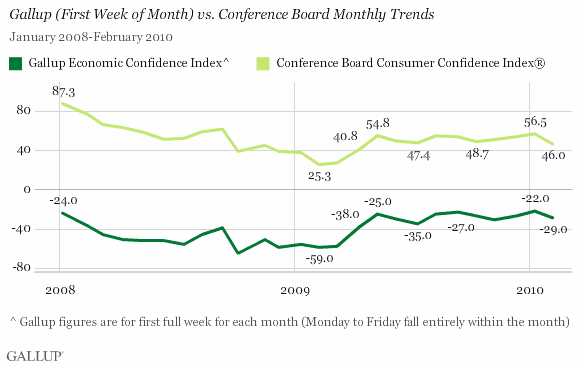
Bottom Line
On the whole, American consumers are more negative than positive about the U.S. economy -- both in their assessments of current conditions and their outlook for whether things are improving or getting worse. While Americans are now slightly more negative than they were at the start of the year, this shift occurred roughly five weeks ago, in mid-January. Since then, Gallup's Daily tracking shows that consumer attitudes have been highly stable.
More broadly, the good news is that consumer attitudes are no worse than they have been for much of the past six months, and are in fact substantially less negative than they were a year ago at this time, and for most of 2008.
about Gallup's economic measures.
Survey Methods
For ���۴�ýDaily tracking, ���۴�ýinterviews approximately 1,000 national adults, aged 18 and older, each day. The ���۴�ýEconomic Index is based on random half-samples of approximately 500 national adults, aged 18 and older, each day. Weekly results are based on telephone interviews with approximately 3,500 adults. For these results, one can say with 95% confidence that the maximum margin of sampling error is ±2 percentage points.
Interviews are conducted with respondents on land-line telephones and cellular phones.
In addition to sampling error, question wording and practical difficulties in conducting surveys can introduce error or bias into the findings of public opinion polls.
